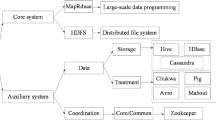Abstract
Internet protocol television viewers spend considerable time browsing through the many existing channels, which is inefficient and time consuming. Although the recommendation system can solve the channel-switching problem, its performance is slow unless it is adapted to read a large amount of data sets. This study proposes a novel cloud-assisted channel-recommendation system under a cloud computing environment, channel association rules (CARs), to speed up the performance of channel switching, thereby help users to find their favorite channels in less time. The CARs algorithm is compared with the conventional (COV) solution and the most frequently selected (MFS) algorithm based on MovieLens data sets. The experimental results indicate that the predictive accuracy of CARs is superior to that of the COV and MFS algorithms. In addition, CARs use parallel computing in MapReduce to distribute large amounts of user history logs across multiple computers for processing. The experimental results show that the proposed algorithm can be employed to efficiently handle big data in a finite time when a huge of cloud servers are rented from commercial cloud providers such as Amazon Elastic Compute Cloud (EC2), Microsoft HDinsight.

















Similar content being viewed by others
References
Chung T-Y, Hsieh C-L, Wang H-Y, Hsu C-Y, Yuan F-C (2011) A fast channel switching system for IPTV based on multi-channel preview. In: International conference on computer games, multimedia and allied technology (CGAT 2011), pp 41–46
Adomavicius G, Tuzhilin A (2005) Toward the next generation of recommender systems: a survey of the state-of-the-art and possible extensions. IEEE Trans Knowl Data Eng 17(6):734–749. doi:10.1109/TKDE.2005.99
Resnick P, Varian HR (1997) Recommender systems. Commun ACM 40(3):56–58. doi:10.1145/245108.245121
Zaletelj J (2008) Recommender system for the multi-channel TV production. In: Tscheligi M, Obrist M, Lugmayr A (eds) Changing television environments, vol 5066. Lecture Notes in Computer Science. Springer, Berlin, pp 102–106. doi:10.1007/978-3-540-69478-6_11
Miller BN, Albert I, Lam SK, Konstan JA, Riedl J (2003) MovieLens unplugged: experiences with an occasionally connected recommender system. In: Proceedings of the 8th international conference on intelligent user interfaces. ACM, Miami, pp 263–266. doi:10.1145/604045.604094
Agrawal R, Imieliński T, Swami A (1993) Mining association rules between sets of items in large databases. In: ACM SIGMOD international conference on management of data, pp 207–216. doi:10.1145/170036.170072
Yi W, Blake MB (2010) Service-oriented computing and cloud computing: challenges and opportunities. IEEE Internet Comput 14(6):72–75. doi:10.1109/MIC.2010.147
Windows Azure (2013). http://www.windowsazure.com. (Accessed 2 Feb 2014)
Amazon EC2 (2013). http://aws.amazon.com/ec2. (Accessed 2 Feb 2014)
Shvachko K, Hairong K, Radia S, Chansler R (2010) The Hadoop Distributed File System. In: 2010 IEEE 26th symposium on mass storage systems and technologies (MSST), pp 1–10. doi:10.1109/MSST.2010.5496972
Dean J, Ghemawat S (2008) MapReduce: simplified data processing on large clusters. Commun ACM 51(1):107–113. doi:10.1145/1327452.1327492
Lin M-Y, Lee P-Y, Hsueh S-C (2012) Apriori-based frequent itemset mining algorithms on MapReduce. In: Proceedings of the 6th international conference on ubiquitous information management and communication. ACM, Kuala Lumpur, pp 1–8. doi:10.1145/2184751.2184842
Ning L, Li Z, Qing H, Zhongzhi S (2012) Parallel implementation of apriori algorithm based on MapReduce. In: 2012 13th ACIS international conference on software engineering, artificial intelligence, networking and parallel and distributed computing (SNPD), pp 236–241. doi:10.1109/SNPD.2012.31
De Pessemier T, Vanhecke K, Dooms S, Martens L (2011) Content-based recommendation algorithms on the Hadoop mapreduce framework. 7th international conference on web information systems and technologies. Ghent University, Department of Information technology, pp 237–240
Deodhar M, Jones C, Ghosh J (2010) Parallel simultaneous co-clustering and learning with map-reduce. In: 2010 IEEE international conference on granular computing (GrC), pp 149–154. doi:10.1109/GrC.2010.54
Schelter S, Boden C, Markl V (2012) Scalable similarity-based neighborhood methods with MapReduce. In: Proceedings of the sixth ACM conference on recommender systems. ACM, Dublin, pp 163–170. doi:10.1145/2365952.2365984
Hyejeong L, Soyoon L, Heekyung K, Hyokyung B (2006) Personalized recommendation schemes for DTV channel selectors. IEEE Trans Consumer Electron 52(3):1064–1068. doi:10.1109/TCE.2006.1706508
Microsoft HDinsight (2014) http://www.windowsazure.com/en-us/documentation/services/hdinsight (Accessed 2 Feb 2014)
Albanese M, Chianese A, d’Acierno A, Moscato V, Picariello A (2010) A multimedia recommender integrating object features and user behavior. Multimedia Tools Appl 50(3):563–585. doi:10.1007/s11042-010-0480-8
Kim J, Kang S, Lim Y, Kim H-M (2013) Recommendation algorithm of the app store by using semantic relations between apps. J Supercomput 65(1):16–26. doi:10.1007/s11227-011-0701-6
Jing J, Jie L, Guangquan Z, Guodong L (2011) Scaling-up item-based collaborative filtering recommendation algorithm based on hadoop. In: 2011 IEEE world congress on services (SERVICES), pp 490–497. doi:10.1109/SERVICES.2011.66
Zhao Z-D, Shang M-S (2010) User-based collaborative-filtering recommendation algorithms on hadoop. In: Third international conference on knowledge discovery and data mining, pp 478–481. doi:10.1109/WKDD.2010.54
Agrawal R, Srikant R (1995) Mining sequential patterns. In: International conference on data engineering, pp 3–14. doi:10.1109/ICDE.1995.380415
Lee S, Lee D, Lee S (2010) Personalized DTV program recommendation system under a cloud computing environment. IEEE Trans Consumer Electron 56(2):1034–1042. doi:10.1109/TCE.2010.5506036
Chang H-Y, Lai C-C, Lin Y-W (2013) A fast SVC-based channel-recommendation system for an IPTV on a cloud and P2P hybrid platform. Comput J. doi:10.1093/comjnl/bxt093
Apache Hadoop Project (2012). http://hadoop.apache.org. (Accessed 2 Feb 2014)
MovieLens Web Site (2014). http://movielens.org. (Accessed 2 Feb 2014)
GroupLens Research Project (2014). http://grouplens.org/datasets/movielens/. (Accessed 2 Feb 2014)
Gunawardana A, Shani G (2009) A survey of accuracy evaluation metrics of recommendation tasks. J Mach Learn Res 10:2935–2962
Kumar V, Singh V (1991) Scalability of parallel algorithms for the all-pairs shortest-path problem. J Parallel Distrib Comput 13(2):124–138. doi:10.1016/0743-7315(91)90083-L
Amdahl GM (1967) Validity of the single processor approach to achieving large scale computing capabilities. In: Spring joint computer conference. ACM, Atlantic City, pp 483–485. doi:10.1145/1465482.1465560
Acknowledgments
This work was supported by National Science Council (NSC) project of Taiwan [NSC-101-2218-E-415-001-], and the Information and Communications Research Laboratories (ICL), Industrial Technology Research Institute (ITRI), Taiwan, Republic of China. Furthermore, we wish to thank Zih-Huan Hong for his assistance in collecting the experiment data.
Author information
Authors and Affiliations
Corresponding author
Rights and permissions
About this article
Cite this article
Chang, HY., Huang, SC. & Lai, CC. A personalized IPTV channel-recommendation mechanism based on the MapReduce framework. J Supercomput 69, 225–247 (2014). https://doi.org/10.1007/s11227-014-1145-6
Published:
Issue Date:
DOI: https://doi.org/10.1007/s11227-014-1145-6




